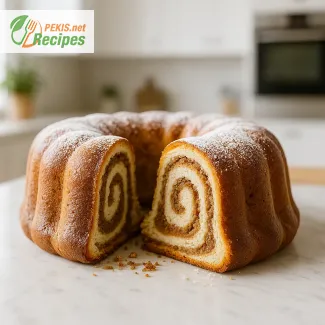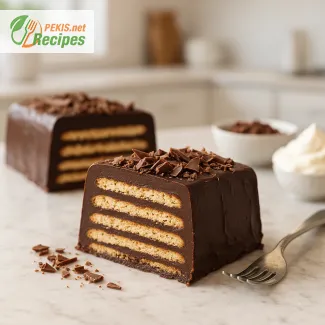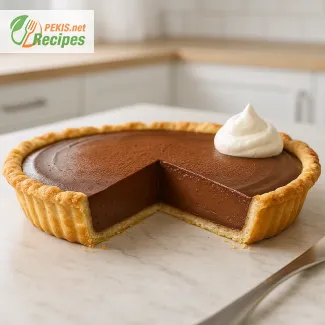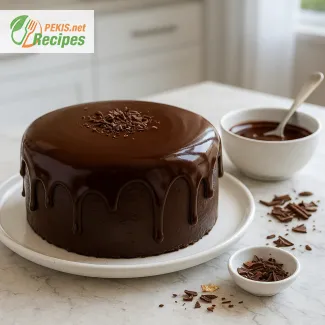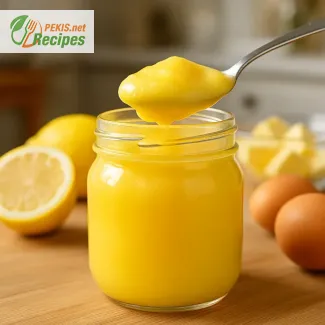
Irresistibly Smooth and Tangy: The Perfect Homemade Lemon Delight
A luscious British classic that brings brightness to every bite
There's something undeniably enchanting about a well-made lemon curd. Its vibrant yellow hue, velvety texture, and perfectly balanced sweet-tart flavor make it a staple in countless desserts. Whether spread on freshly baked scones, dolloped into tarts, swirled through yogurt, or layered in cakes, this homemade lemon curd recipe is the kind of culinary essential that transforms ordinary treats into something unforgettable.
Lemon curd, also known in culinary circles as English lemon cream, originated in 19th-century Britain as a refined alternative to fruit preserves and jam. It has since become a beloved component of both traditional and modern desserts. What sets it apart is its exquisite creaminess, derived from a slow, gentle cooking process that emulsifies egg yolks, sugar, butter, and freshly squeezed lemon juice into a luxurious spread.
At the heart of this classic lies the lemon—a fruit celebrated for its bright, zesty essence. When used in curd form, it lends a burst of citrus that feels both refreshing and indulgent. This makes lemon curd an ideal contrast to buttery pastries or rich, creamy desserts. It's no wonder this recipe is cherished by pastry chefs, home bakers, and culinary enthusiasts around the globe.
Making your own lemon curd from scratch may sound like a meticulous task, but with the right method and a bit of patience, it's a straightforward process that delivers incredible results. Unlike store-bought versions, homemade lemon curd is free from preservatives, artificial flavorings, and excess sweeteners. It showcases the natural acidity and aromatic zest of real lemons in their purest form.
What truly elevates a good lemon curd to greatness is the quality of ingredients. Fresh lemons, preferably unwaxed and organic, make all the difference, imparting intense citrus flavor and rich color. Using real butter instead of margarine adds depth and smoothness, while egg yolks give the curd its silky structure and signature thickness.
Another advantage of preparing lemon curd at home is the versatility it offers. This recipe allows you to control the sweetness, tartness, and consistency based on your preferences. If you like it extra tangy, a touch more zest can work wonders. For a sweeter, more mellow version, reduce the lemon juice slightly or balance it with a milder sugar like caster or superfine. Either way, you’re left with a gourmet product that’s as versatile as it is delicious.
Lemon curd can be used in more ways than you might imagine. It’s a sublime filling for lemon meringue pies, adds an elegant twist to cheesecakes, and becomes the star of any Victoria sponge cake. For breakfast, try it stirred into porridge or as a topping on pancakes. For a more luxurious brunch, serve it with brioche or use it as a base for fruit parfaits. Its ability to adapt across sweet and even savory applications makes it a must-have in every well-stocked kitchen.
Another benefit of this lemon curd recipe is its shelf life. When stored in sterilized jars and refrigerated properly, it can last up to two weeks—though it's often gone long before then. It also makes a thoughtful and elegant homemade gift, especially when packaged in a decorative jar and tied with a ribbon.
This easy lemon curd recipe strikes the perfect balance between sweet and tart, delivering a rich, spreadable custard that’s both refreshing and indulgent. The preparation method is simple, requiring only a few basic kitchen tools: a saucepan, a whisk, and a fine-mesh strainer. In less than 30 minutes, you can produce a jar of golden, citrusy joy that elevates any dish it touches.
Whether you're preparing a teatime treat, assembling a layered dessert, or looking to brighten up your breakfast routine, this lemon curd will quickly become a go-to favorite. Its smooth consistency, intense flavor, and beautiful presentation make it one of the most rewarding preserves you can make at home. With just a few fresh ingredients and this trusted recipe, you’re moments away from a creation that’s bright, creamy, and full of citrus sunshine.
Step 1 – Prepare the lemons:
Wash and dry the lemons. Finely grate the lemon zest and squeeze the juice to get 200 ml (6.8 fl oz). Strain the juice through a fine sieve to remove seeds and pulp.
Step 2 – Melt the butter:
In a heatproof bowl, combine the butter and sugar. Place the bowl over a saucepan of simmering water (double boiler method) and stir until the butter is completely melted and the sugar starts to dissolve.
Step 3 – Add the lemon juice and zest:
Pour in the lemon juice and zest while stirring constantly with a whisk. The mixture may look slightly separated at this stage, but will come together once the eggs are added.
Step 4 – Add the eggs:
In a separate bowl, lightly beat the egg yolks and whole eggs. Slowly pour them into the lemon mixture while whisking continuously to prevent curdling. Maintain a low heat and continue stirring constantly for about 10–15 minutes until the mixture thickens and coats the back of a spoon.
Step 5 – Strain and jar:
Remove from heat and immediately strain the curd through a fine mesh sieve into a clean bowl to ensure a smooth texture. Pour into sterilized glass jars while still warm and seal immediately.
Step 6 – Cool and store:
Allow the jars to cool to room temperature before refrigerating. Store in the fridge for up to 2 weeks. Once opened, consume within 7 days.
Creative Enhancements for Elevating Your Lemon Curd
Practical tips and expert techniques for a smoother, richer, and more versatile lemon curd
Lemon curd is already a beloved classic, but there's always room to refine and personalize a traditional recipe. By understanding the science behind the ingredients and exploring smart substitutions, it's possible to create a version that suits your taste preferences or dietary needs without compromising on texture or flavor. In this guide, we’ll look at how to take the basic lemon curd recipe and enhance it to make it even more delicious, healthier, or more unique, all while maintaining its silky, spreadable consistency and bright citrus zing.
Choosing the right type of lemon
The foundation of a perfect lemon curd lies in the quality and variety of lemons used. While standard lemons such as Eureka or Lisbon are widely available and effective, using Meyer lemons can dramatically alter the flavor profile. These hybrid lemons are sweeter, less acidic, and have a subtle floral note, making the resulting curd smoother and less tangy. If you prefer a milder, more aromatic curd, switching to Meyer lemons is an excellent option.
Using zest strategically for deeper flavor
Most recipes call for lemon zest, but how and when it’s added can impact the end result. For intensified lemon flavor, consider infusing the zest into the sugar before adding it to the butter. This allows the essential oils from the zest to permeate the sugar, adding an extra layer of citrus complexity. You can also strain the zest out after cooking for a smoother texture, especially if you plan to use the curd in elegant desserts like macarons or tartlets.
Replacing sugar for a healthier touch
Standard lemon curd contains a generous amount of white sugar. To make it healthier, consider natural sweeteners such as honey, maple syrup, or agave nectar. These not only reduce refined sugar content but also add subtle flavor notes. Honey adds a floral undertone, maple syrup contributes warmth and depth, while agave keeps the flavor neutral but reduces the glycemic index. Keep in mind that liquid sweeteners can slightly thin the curd, so adjusting the cooking time may be necessary.
Adding a pinch of salt or vanilla for balance
Although often overlooked, a small pinch of fine sea salt can enhance the overall flavor by balancing the acidity and sweetness. Likewise, a few drops of pure vanilla extract or vanilla bean paste can round out the sharpness of the lemon and introduce a delicate warmth. These are subtle changes, but they add sophistication and complexity to the curd.
Thickening alternatives for dietary needs
Traditional lemon curd relies on eggs for thickening, which makes it unsuitable for people with egg allergies or those following a vegan diet. For a vegan lemon curd, you can use a combination of cornstarch or arrowroot powder with plant-based milk and lemon juice. While the texture may not be as rich as the egg-based version, the flavor can still shine with the right balance of acidity and sweetness. Coconut milk can be used for a creamier, tropical twist.
Achieving the ideal texture
One of the most common mistakes in making lemon curd is overheating, which can lead to curdled eggs. To avoid this, always use the double boiler method and keep the heat gentle. Constant stirring is essential. If curdling occurs, blending the mixture or passing it through a sieve can help salvage it. Additionally, using a thermometer ensures precision—aim for a temperature between 75–82°C (167–180°F), where the eggs thicken but don’t scramble.
Enhancing shelf life and stability
While lemon curd is best enjoyed fresh, it can be stored for longer if handled properly. Sterilizing jars before filling and adding a small amount of citric acid can help preserve it naturally. You can also freeze lemon curd in airtight containers for up to three months. When defrosted slowly in the refrigerator, it retains most of its original texture and taste.
Making it more luxurious
To create a more decadent version, consider whisking in a tablespoon of heavy cream or mascarpone cheese after cooking. This adds a velvety richness that’s ideal for pairing with berries, panna cotta, or as a cake filling. Some pastry chefs even fold chilled lemon curd into whipped cream to create a lemon mousse, which offers a light and airy texture perfect for summer desserts.
Flavor pairings to experiment with
Lemon curd can serve as a base for a variety of flavor infusions. Popular pairings include lavender, ginger, rosemary, or even a hint of chili for a spicy twist. To experiment, steep herbs or spices in the lemon juice before cooking and then strain them out. This can bring an unexpected yet delightful edge to your curd, making it perfect for gourmet desserts.
Why homemade always wins
Homemade lemon curd outshines store-bought versions for several reasons. First, you have full control over the ingredients, allowing you to avoid artificial preservatives and flavorings. Second, the flavor is significantly fresher, and the texture can be tailored to your liking—whether slightly runny for drizzling or firm enough to pipe into pastries. Lastly, homemade curd can be adapted seasonally, depending on the type of citrus available, from limes to blood oranges or even yuzu.
The beauty of lemon curd lies in its versatility and adaptability. With a few thoughtful tweaks, it can transform into something uniquely yours—whether you're aiming for a healthier dessert spread, a gourmet patisserie filling, or simply a zesty companion for breakfast toast. By mastering the basics and exploring flavor enhancements, your lemon curd will stand out every time.
Allergens and gluten:
Contains: Eggs, milk (butter).
Gluten: None (naturally gluten-free).
To make dairy-free: Replace butter with plant-based margarine.
To make egg-free: Use commercial egg replacer or a mix of cornstarch and water for thickening, but texture will vary.
Vitamins and minerals (per 100 g):
Vitamin C: 24 mg – strengthens the immune system, aids iron absorption
Vitamin A: 125 µg – supports vision and immune health
Calcium: 22 mg – important for bones and teeth
Potassium: 85 mg – regulates fluid balance and muscle contractions
Iron: 0.3 mg – essential for red blood cell formation
Antioxidants (per 100 g):
Flavonoids (from lemon zest): ~12 mg – anti-inflammatory, supports heart health
Vitamin C: 24 mg – neutralizes free radicals, supports skin regeneration
Carotenoids: trace – minor antioxidant support
